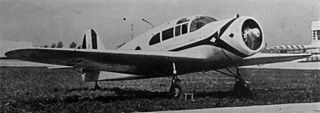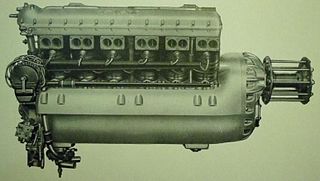
The Bristol Perseus was a British nine-cylinder, single-row, air-cooled radial aircraft engine produced by the Bristol Engine Company starting in 1932. It was the first production sleeve valve aero engine.

The Taurus was a British 14-cylinder two-row radial aircraft engine, produced by the Bristol Engine Company starting in 1936. The Taurus was developed by adding cylinders to the existing single-row Aquila design and transforming it into a twin-row radial engine, creating a powerplant that produced just over 1,000 horsepower (750 kW) with very low weight.

The Messerschmitt Bf 108 Taifun was a German single-engine sport and touring aircraft, developed by Bayerische Flugzeugwerke in the 1930s. The Bf 108 was of all-metal construction.

The Nakajima Sakae was a two-row, 14-cylinder air-cooled radial engine used in a number of combat aircraft of the Imperial Japanese Navy and Imperial Japanese Army before and during World War II.

The Fiat A.80 was an 18-cylinder, twin-row, air-cooled, radial aircraft engine produced during World War II. Rated at 1,000 hp (745 kW), it was a more powerful development of the 14-cylinder Fiat A.74.

The Alfa Romeo 115 was an Italian 6-cylinder air-cooled inverted inline engine for aircraft use, mainly for training and light planes, based on the de Havilland Gipsy Six engine. Production totalled approximately 1,600 units. Derivatives of the 115 include the -1, bis, ter and Alfa Romeo 116.

The Alfa Romeo 110 was an Italian four cylinder air-cooled inverted inline engine for aircraft use, mainly for trainers and light aircraft. The Alfa Romeo 110 was based on the de Havilland Gipsy Major, with approximately 500 units produced. Derivatives of the 110 include the -1, ter and Alfa Romeo 111.

The Jacobs R-755 is a seven-cylinder, air-cooled, radial engine for aircraft manufactured in the United States by the Jacobs Aircraft Engine Company.

The Nardi FN.305 was an Italian fighter trainer and liaison monoplane developed by the Fratelli Nardi company.

The Nardi FN.310 was an Italian four-seat touring monoplane similar but larger than the earlier Nardi FN.305 and produced by the Fratelli Nardi company.

For the aircraft of the same name, see Fiat AS.2 (aircraft)

The Walter Bora was a Czechoslovakian nine-cylinder, air-cooled radial engine for powering light aircraft that was developed in the 1930s by Walter Aircraft Engines.

The Fiat A.24 was an Italian water-cooled aircraft engine from the 1920s, built in modest numbers. It produced 520 kW (700 hp).

The Fiat A.30 R.A. was an Italian water-cooled aircraft engine from the 1920s, built in large numbers and serving with several air forces up to the beginning of World War II. It produced 447 kW (600 hp).

The Fiat A.25 was an Italian water-cooled aircraft engine from the 1920s. It produced 708 kW (950 hp) and was used by the Regia Aeronautica for fifteen years to power their Fiat BR.2 and BR.3 bombers.
The Isotta Fraschini Beta was an air cooled aircraft engine produced by the Italian engineering company Isotta Fraschini in the 1940s.

The Argus As 17 was an air cooled six-cylinder in-line aircraft engine designed by the German engineering company Argus Motoren in the 1930s. Developed from the same company's smaller As 8, the engine was produced in ratings between 200 and 280 hp. First demonstrated in 1934, it powered a number of competitors at the Challenge International de Tourisme that year, including the Messerschmitt Bf 108. Argus produced it in small numbers as German manufacturers like Messerschmitt preferring V-8 alternatives for their aircraft.

The Fiat A.82 was an air cooled radial engine with 18 cylinders developed by the Italian engineering company Fiat and produced in small numbers during World War II. It was one of the most powerful aircraft engines produced in Italy and the culmination of series of successively larger engines developed from the A.74. It was used as the power plant for one operational aircraft, the Fiat BR.20bis bomber.

The Fiat A.60 was a four-cylinder, air-cooled inline engine developed in Italy in the 1930s.

The Fiat A.53 was a seven-cylinder, air-cooled radial piston engine developed in Italy in the 1930s as a powerplant for aircraft.



















